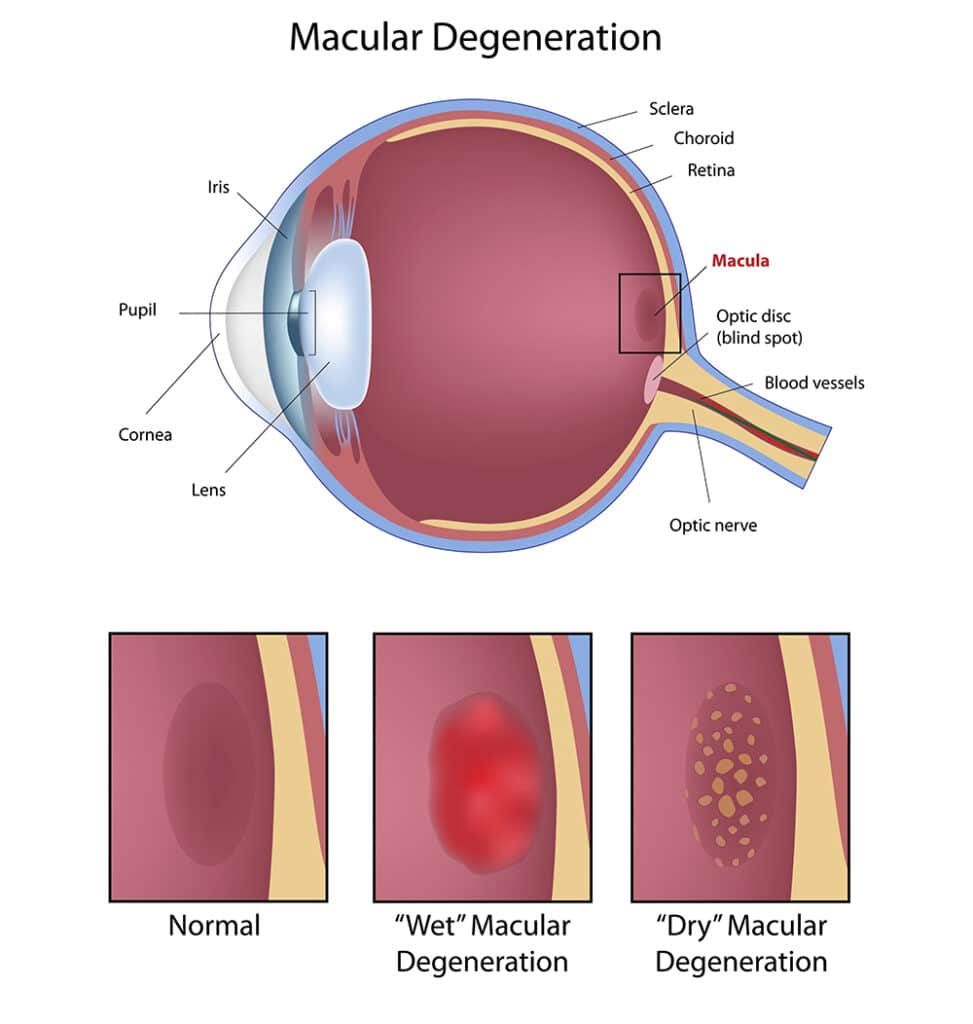

Age-related macular degeneration (AMD) is a deterioration or breakdown in the central part of the retina called the macula. The macula is the part of the retina that is responsible for your central vision, allowing you to see fine details clearly. Even though the macula is quite small in area (about 2mm), it is much more sensitive to detail than the rest of the retina. The macula is what allows you to thread a needle, read small print, and read street signs. The peripheral retina gives you side, or peripheral, vision. If someone is standing off to one side of your vision, your peripheral retina helps you know that person is thereby allowing you to see his or her general shape. With macular degeneration, you may have symptoms such as blurriness, dark areas or distortion in your central vision, and perhaps permanent loss of your central vision. It usually does not affect your side, or peripheral, vision. For example, with advanced macular degeneration, you could see the outline of a clock, yet may not be able to see the hands of the clock and tell what time it is. Causes of macular degeneration include the formation of deposits called drusen under the macula, and in some cases, the growth of abnormal blood vessels under the macula. With or without treatment, macular degeneration alone almost never causes total blindness. People with more advanced cases of macular degeneration continue to have useful peripheral vision. In many cases, macular degeneration’s impact on your vision can be minimal. When macular degeneration does lead to loss of vision, it usually begins in just one eye, though it may affect the other eye later. Many people are not aware that they have macular degeneration until they have a noticeable vision problem or until it is detected during an eye examination.
Dry, or atrophic, macular degeneration is the most common form of macular degeneration. This condition is caused by aging and thinning of the tissues of the macula. Macular degeneration usually begins when tiny yellow or white pieces of fatty protein called drusen form under the retina. Eventually, the macula may become thinner and stop working properly. With dry macular degeneration, vision loss is usually gradual. People who develop dry macular degeneration must carefully and constantly monitor their central vision. If you notice any changes in your vision, you should tell your ophthalmologist right away, as the dry form can change into the more damaging form of macular degeneration called wet (exudative) macular degeneration. While there is no medication or treatment for dry macular degeneration, some people may benefit from a vitamin therapy regimen for dry macular degeneration.

Wet macular degeneration is less common but causes more severe vision loss than the dry type. Only 10 percent of people who have macular degeneration have the wet form. Wet macular degeneration occurs when abnormal blood vessels begin to grow underneath the macula. This blood vessel growth is called choroidal neovascularization (CNV) because these vessels grow from the layer under the retina called the choroid. These new blood vessels may leak fluid or blood, blurring or distorting central vision. Vision loss from this form of macular degeneration may be faster and more noticeable than that from dry macular degeneration. The longer these abnormal vessels leak or grow, the more risk you have of losing more of your detailed vision. Also, if abnormal blood vessel growth happens in one eye, there is a risk that it will occur in the other eye. The earlier that wet macular degeneration is diagnosed and treated, the better chance you have of preserving some or much of your central vision.
Much new information on macular degeneration has been discovered. Genetic changes appear to be partially responsible for macular degeneration. Age is the single most significant risk factor. Many older people develop macular degeneration as part of the body’s natural aging process. One large study found that the risk of getting macular degeneration jumps from about 2 percent of middle-aged people in their 50s to nearly 30 percent in people over age 75. Our bodies constantly react with the oxygen in our environment. Over our lifetimes, as a result of this activity, our bodies produce tiny molecules called free radicals. These free radicals affect our cells, sometimes damaging them. This is called oxidative stress and is thought to play a major role in how macular degeneration develops. Heredity is another risk factor for macular degeneration. People who have a close family member with the disease have a greater chance of developing macular degeneration themselves. Some studies have shown that inflammation may play a role in macular degeneration development. Inflammation is the way the body’s immune system fights off infection, but an overactive immune system with its associated inflammation may be a risk factor for macular degeneration. Smoking and high blood pressure are associated with the wet form of macular degeneration. Research also suggests there may be a link between being obese and having early or intermediate-stage macular degeneration develop into the advanced (wet) form.